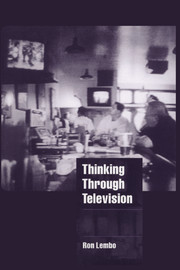Introduction: Situating my experience with television
Published online by Cambridge University Press: 22 September 2009
Summary
In my studies of television, I have wanted nothing less than to, figuratively, get inside people's heads to determine the mindfulness that emerges from their use of the medium, and, further, to understand its ritual significance within the culture of television use. In doing so, I have wanted to gain a better understanding of the roles that the structural features of television and the broader, meaningful context of everyday play in giving shape, or form, to this mindfulness. I have wanted to know how it is that television viewing actually becomes a ritual practice for people, and what participation in this ritual as opposed to others means for people over the long run.
In research that I conducted with working people over several years, research that included indepth interviewing, watching television with people, the completion of viewer diaries, and more casual conversations with people at work, in the home, and elsewhere, I found that one third of the people included in my study used television in a continuous manner on a day-in and day-out basis. Watching television, they said, served as their primary form of relaxation and enjoyment during the time they spent away from work.
What I have come to call the “continuous” use of television is familiar territory to me. Like the people I watched with and talked to, I, too, grew up with television and, as it was for many of them, the television was on much of the time when I was at home.
- Type
- Chapter
- Information
- Thinking through Television , pp. 1 - 14Publisher: Cambridge University PressPrint publication year: 2000



